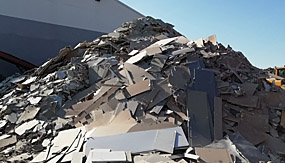
Demolition site waste. © Pielinen Karelia Development Center Pikes
The partner of the Circwaste project, Pielinen Karelia Development Center Pikes, is one of the partial implementers of the Circwaste project. The aim of the Pikes sub-projects has been to search for and test sustainable local methods of recovery of by-products and waste with North Karelian industrial companies and municipalities.
During the sub-project, several studies were carried out, the first results of which were already published on the website Materiaalitkiertoon.fi in May last year.
The demolition process of buildings better linked to circular economy
One of Pikes's projects clarified the criteria for the procurement of the demolition of the Kyröntuva service home in the city of Nurmes. The local procurement criteria for demolition processes had not previously placed such a significant emphasis on the circular economy, so this was a new regional experiment. The experiment provided valuable local experience, and as a result, the city’s demolition procurement process was updated to promote the circular economy better.
90 per cent of all materials at the demolition site were recycled and concrete and brick waste was utilised locally in civil engineering. The generated concrete and brick waste were delivered powdered by Ylä-Karjalan Kuljetus Oy from the demolition site to an area five kilometres away in Kotilanvaara. There, the powdered concrete waste was crushed to a grain size of about 90 millimetres and residuum of concrete reinforcement was removed. Crushed concrete is used in the same area in an environmentally licensed field structure.
"Demolition did not take longer than usual in terms of time, and according to profitability calculations, the method is also economically viable in larger demolition sites," says Heidi Tanskanen, Corporate Expert at Pikes.
The pilot experiment identified development needs and lessons related to demolition, which will be utilised in the municipality's future demolition sites.
A joint raw material database tool for metal companies tested
There are several small metal companies operating in the Nurmes area, and they have cooperated closely under the name Metallinyrkki, Metal fist. The aim of the experiment was to create a joint raw material database of local metal companies, in which information on the stock situation of metal sheets left over from production would be monitored and shared. When ordered from wholesalers, the delivery of metal sheets can take significantly longer than when picked up from a neighbour.
“However, the tried and tested digital tool was found to be laborious to implement. For this reason, there were no functioning chains between waste producers and waste users. However, the experiment increased the awareness of the participating companies about the circular economy as well as mutual communication and cooperation. Cooperation continues between local companies through a Whatsapp group,” says Tanskanen.
Food waste reduced with pedagogy and digitalisation
In Pikes's third experiment, the aim was to find out the amount of food waste in two local canteens, as well as the effects of information and pedagogical methods on reducing waste. The experiment utilised Biovaaka Oy's digital scale application. With the help of the bio scale, the kitchens were able to monitor the amount of food waste generated in real time and at the same time diners received immediate feedback on the amount of food waste.
A demo on one plate food waste was able to reduce food waste to some extent and increase the awareness of restaurant kitchens and diners about ways to monitor and reduce food waste.
“Based on the results of the experiment, it has been possible to reduce the amount of food waste generated at the locations during both experiments. There seems to be less and less food waste at both locations and we can see the downward trend continuing. If the experiment continues, we believe that cost savings can be achieved in both locations,” says Tanskanen.
An interesting and even surprising finding is that there was a greater amount of food waste on days when the children’s favourite foods were served as the children took more food than they could eat.
Heating plant ash to practical use
During summer 2020, Pikes still tests the utilisation of the ash from the local bioheating plant in forest road construction.
“At this stage, we have carried out a study with experts from the Tapio Group. Local ash has previously ended up in landfills. The challenge is that only small amounts of ash are available locally. It is estimated that the ash should be transported a maximum of about ten kilometres, and long-term storage of the ash is not profitable,” describes Tanskanen.
The forthcoming experiment will provide valuable practical information for future experiments on the use of ash.
More information